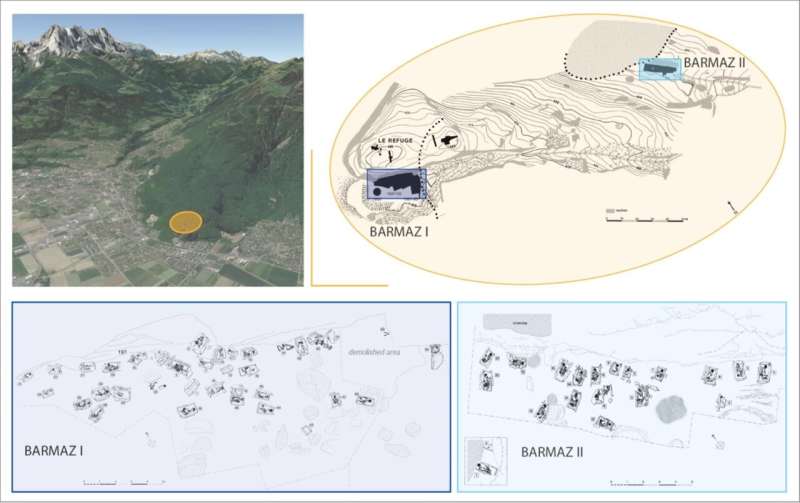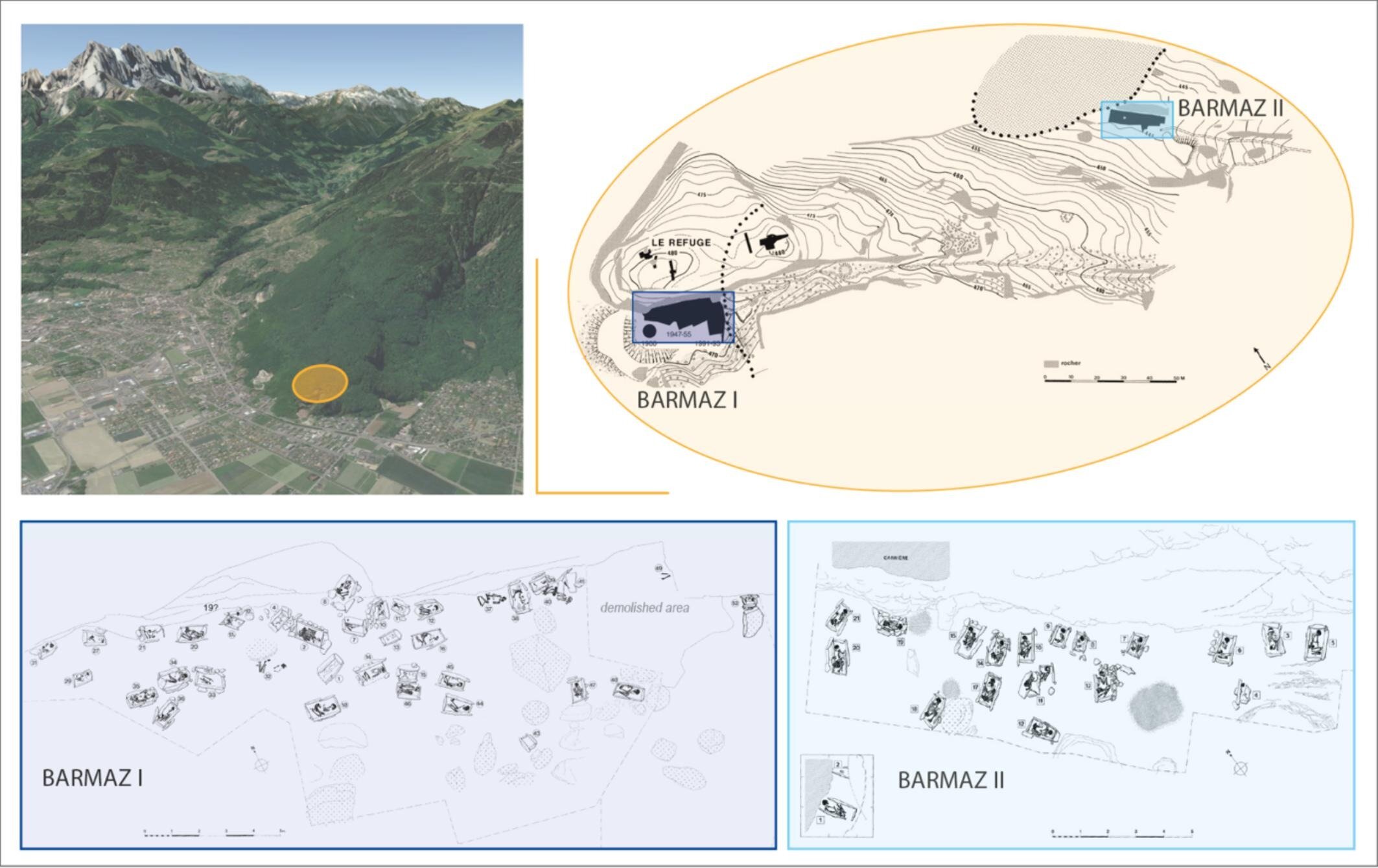
In orange, the location of the Barmaz site, looking south. It is located on the plain, at the foot of the Chablais massif, which rises to an altitude of 2500 m. The site is divided into two contemporary burial areas called Barmaz I (dark blue) and Barmaz II (light blue) (Honegger and Desideri 2003, modified). Credit: Journal of Archaeological Sciences: Reports (2024). DOI: 10.1016/j.jasrep.2024.104585
Using isotope geochemistry, a team from the University of Geneva (UNIGE) has discovered new information about the Barmaz necropolis in Valais (Switzerland): 14% of the people buried 6,000 years ago at this site were not natives. Furthermore, the study suggests that this Middle Neolithic agro-pastoral society – one of the oldest known in the western part of Switzerland – was relatively egalitarian.
Carbon, nitrogen and sulfur isotope ratios contained in the bones reveal that all members of the community, including people from other countries, had access to the same food sources. These results are published in Journal of Archaeological Sciences: Reports.
The Neolithic period marked the beginning of animal husbandry and agriculture. In Switzerland, this period spans between 5500 and 2200 BC. The first agropastoral communities gradually transitioned from a predatory economy—in which hunting and gathering provided the nutrients essential for survival—to a production economy.
This fundamentally changed the dietary habits and functioning dynamics of Neolithic populations. The bones and teeth of individuals preserve chemical traces that scientists are now able to detect and interpret.
The aim of the study carried out by Déborah Rosselet-Christ, a PhD student in the Laboratory of African Archeology and Anthropology at the UNIGE Faculty of Sciences, is to apply isotope analysis to human remains dating from the Neolithic period to learn more about them. diet and mobility.
The levels of certain isotopes of carbon, nitrogen, sulfur and strontium depend on the environment in which each individual lives and eats. Isotopes are atoms that have the same number of electrons and protons, but a different number of neutrons. This very precise and delicate technique is being applied for the first time to the alpine agro-pastoral populations of the Middle Neolithic period in the western part of Switzerland.
Mobility according to the second molar
Excavated in the 1950s and 1990s, the Barmaz site at Collombey-Muraz in the Chablais region of Valais is one of the oldest remains of agro-pastoral societies in western Switzerland that has preserved human remains. It includes two necropolises containing the remains of about seventy individuals. For her master’s degree, Déborah Rosselet-Christ, the first author of the study, selected 49 of them (as many women as men) from whom she systematically took collagen samples from certain bones, as well as enamel fragments from their second molars.
“The second molar is a tooth whose crown is formed between the ages of three and eight,” explains the researcher.
“Once formed, tooth enamel is not renewed for the rest of life. Its chemical composition reflects the environment in which its owner lived during childhood. Strontium (Sr) is a good indicator of mobility. The abundance ratio between the two its isotopes – that is, their proportion – varies greatly depending on the age of the surrounding rocks.
Analysis of strontium isotope ratios in 49 individuals from Barmaz reveals a high degree of homogeneity in most of them and significantly different values in only 14% of the samples, indicating a different origin.
“The technique makes it possible to determine that these are individuals who did not live the first years of their lives in the place where they are buried, but it is more difficult to determine where they come from,” says Jocelyne Desideri, senior lecturer at Laboratory of African Archeology and Anthropology at UNIGE Faculty of Science, last author of the article.
“Our results show that people were on the move at that time. This is not surprising, as several studies have highlighted the same phenomenon in other places and at other times during the Neolithic period.”
Diet recorded in collagen
Collagen is used to determine the isotope ratios of carbon (δ13C), nitrogen (δ15N) and sulfur (δ34S). Each measurement provides information on specific aspects of the diet, such as categories of plants according to the type of photosynthesis they use, the amount of animal protein or the intake of aquatic animals.
As bones are constantly renewed, the results are only relevant to the last years of an individual’s life. That said, the scientists were able to conclude that these former inhabitants of the Barmaz region had a diet based on terrestrial (rather than aquatic) sources, with a very high consumption of animal protein.
“What’s more interesting is that we didn’t measure any differences between men and women,” notes Déborah Rosselet-Christ.
“Nor even between natives and non-natives. Therefore, these results suggest equal access to food resources among different members of the group, regardless of their origin or gender. However, this is not always the case. There are, for example, dietary differences between the sexes in Neolithic populations in the south of France”.
A clearer picture of agro-pastoral societies
However, the scientists were able to show that non-native people were buried in only one of the necropolises (Barmaz I) and that the highest nitrogen isotope levels were measured in the other (Barmaz II). As the two necropolises were contemporaneous (and only 150 meters apart), the latter observation raises the question of whether there was a difference in social status between the two groups of the dead.
“Our isotope measurements are an interesting complement to other approaches used in archaeology,” says Jocelyne Desideri. “They help to clarify the picture we are trying to paint of the life of these early Alpine agro-pastoral societies, the relationships between individuals and their mobility.”
Déborah Rosselet-Christ is currently pursuing this work as part of her PhD thesis, co-supervised by Jocelyne Desideri and Massimo Chiaradia (Senior Lecturer, Department of Earth Sciences).
Working together with a multidisciplinary team specializing in genetics, palaeopathology, calculus and morphology, she is expanding her field of study to include other sites in the Valais and Val d’Aosta in Italy, covering a wider period Neolithic and using other isotopes, such as neodymium, which are potentially interesting in a prehistoric archaeological context.
More information:
Déborah Rosselet-Christ et al, Early Swiss alpine agropastoral societies: The contribution of isotope analysis to the study of their diet and mobility, Journal of Archaeological Sciences: Reports (2024). DOI: 10.1016/j.jasrep.2024.104585
Provided by the University of Geneva
citation: Isotope study suggests men and women had equal access to resources 6,000 years ago (2024, June 13) Retrieved June 14, 2024 from https://phys.org/news/2024-06-isotope-men- women-equal-access. html
This document is subject to copyright. Except for any fair agreement for study or private research purposes, no part may be reproduced without written permission. The content is provided for informational purposes only.
